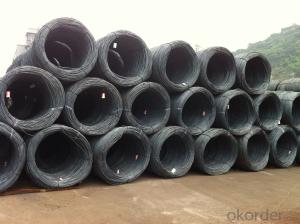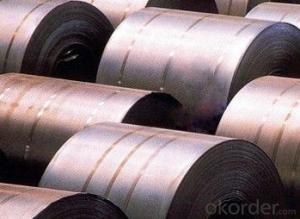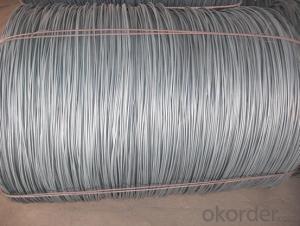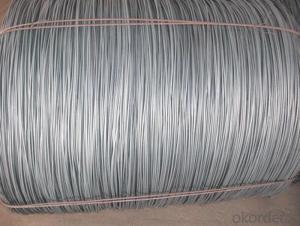Wire rod high quality hot rolled 5.5mm-14mm
- Loading Port:
- Tianjin
- Payment Terms:
- TT OR LC
- Min Order Qty:
- 25 m.t.
- Supply Capability:
- 20000000 m.t./month
OKorder Service Pledge
OKorder Financial Service
You Might Also Like
WIRE ROD Details:
| Minimum Order Quantity: | m.t. | Unit: | m.t. | Loading Port: | |
| Supply Ability: | m.t./month | Payment Terms: | TT OR LC |
Product Description:
Steel Grade: Q195 Standard: ASTM, GB
Diameter: 5.5mm, 6.5mm, 7mm,8mm,9mm,10mm,12mm,14mm
6.5mm can be drawing into 2mm/8.0mm can be drawing into 3mm
Type: Drawn Wire in Coil, each coil weight about 2MT
Brand Name: N-RIVER Place of Origin: Hebei, China
Chemical Composition:
Please kindly find our chemistry of our material based on Q195 as below for your information
Trademark | Rank | Chemical composition (quality score) % | |||||
C | Si | Mn | S | P | |||
≤ | ≤ | ≤ | |||||
Q195 | 0.06-0.12 | 0.30 | 0.25 | 0.050 | 0.045 | ||
Trademark | Rank | Pulling Test | |||||
Bend PointΔs/Mpa | Tensile Strength | Elongation Ratioδ5% | |||||
Thickness (Diameter) /MM | Thickness (Diameter) /MM | ||||||
≤16 | 16-40 | ≤16 | 16-40 | ||||
≥ | ≥ | ||||||
Q195 | 195 | 185 | 315-390 | 33 | 32 | ||
Usage and Applications of Wire Rod Q195:
After hot-rolled the products shaped into coil and delivery as finished product, including round, square, rectangular, hexagonal and so on. Since most of the products are round, it is generally called wire rod. Carbon steel wire rod is widely used in construction and manufacturing. Carbon steel wire rod is mainly used for reinforcement of reinforced concrete and welded structure or reprocessed (roberts , nail, etc.) materials, especially used to produce wire drawing, welding electrode, nails, spring, electronic, precise machinery parts and so on
Wire Rod in Container
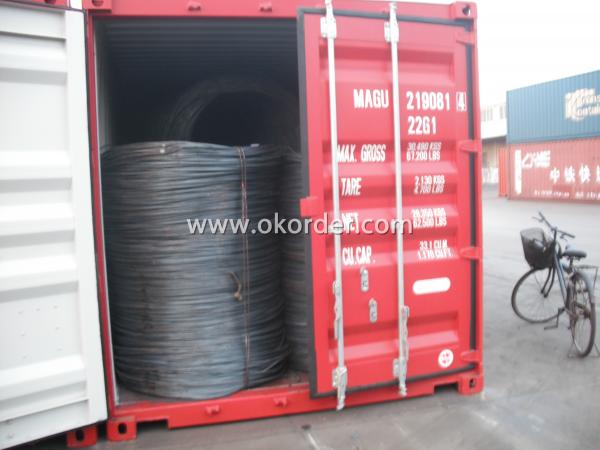
Wire Rod in Bulk Vessel
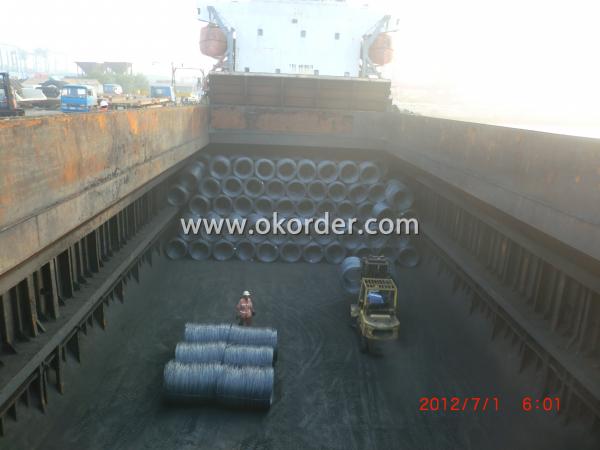
Note:
- Q:How is the ductility of steel wire rod determined?
- The ductility of steel wire rod is determined through various mechanical tests and measurements. One of the commonly used methods to evaluate ductility is the tensile test. In this test, a sample of the steel wire rod is pulled until it breaks, and the amount of deformation it undergoes before fracture is measured. During the tensile test, the steel wire rod is subjected to an increasing load or force, while its elongation or deformation is continuously measured. The force required to stretch the wire to a specific length is recorded, and the resulting stress-strain curve is plotted. The ductility of the steel wire rod can be determined from this stress-strain curve. The elongation or deformation at the point of fracture is an important parameter in assessing its ductility. Higher elongation indicates greater ductility, as it implies that the material can undergo more deformation before breaking. Apart from the tensile test, other tests such as the bend test and impact test can also be used to evaluate the ductility of steel wire rod. In the bend test, the wire is bent to a specific angle without fracturing. The ability to bend without breaking indicates good ductility. Similarly, the impact test measures the energy absorbed by the wire when it is subjected to a sudden impact. A higher energy absorption indicates better ductility, as it implies that the material can absorb and distribute the impact forces without fracturing. In conclusion, the ductility of steel wire rod is determined through mechanical tests such as the tensile test, bend test, and impact test. These tests measure the amount of deformation the wire can undergo before breaking, the ability to bend without fracturing, and the energy absorption during impact, respectively.
- Q:What are the different types of steel wire rod drawing processes?
- There are several types of steel wire rod drawing processes, including cold drawing, hot drawing, and direct drawing. In cold drawing, the wire rod is pulled through a series of dies at room temperature to reduce its diameter and increase its length. Hot drawing involves heating the wire rod before the drawing process to make it more malleable and easier to deform. Direct drawing, on the other hand, eliminates the need for intermediate annealing by performing the drawing process immediately after hot rolling.
- Q:How are steel wire rods used in the manufacturing of wire brushes?
- Wire brushes rely on steel wire rods as a vital ingredient in their production. These rods act as the foundation for the brush's bristles. The first step involves drawing the steel wire rods through a series of dies to decrease their diameter and increase their length. This process, known as wire drawing, ensures that the wire attains the desired thickness and strength necessary for the brush's bristles. Once the wire has been drawn, it is then cut into specific lengths based on the brush's size. These cut lengths are then inserted into the brush's base, typically made of wood or plastic, and secured in place using various techniques like stapling or twisting. The steel wire rods utilized in wire brushes are generally crafted from high-quality carbon steel, which offers the necessary durability and flexibility for efficient brushing. Furthermore, the wire is frequently coated with a layer of protective material, such as zinc or brass, to prevent corrosion and enhance its lifespan. The bristles made from steel wire rods find extensive usage in a variety of industries and applications. Wire brushes with steel bristles are commonly employed for cleaning, deburring, polishing, and surface preparation tasks. They excel in removing rust, paint, and other stubborn residues from metal surfaces. The strength and resilience of steel wire bristles make them suitable for heavy-duty cleaning and abrasive tasks. To summarize, steel wire rods are essential in the production of wire brushes as they serve as the raw material for the bristles. Through processes like wire drawing, cutting, and securing, these rods are transformed into durable and efficient bristles that are widely utilized in multiple industries for cleaning and surface preparation purposes.
- Q:What are the main factors influencing the supply and demand of steel wire rod?
- There are various primary factors that affect the supply and demand of steel wire rod. 1. Economic expansion: The general economic growth of a nation or region plays a significant role in determining the demand for steel wire rod. As the economy expands, there is typically an increase in construction and infrastructure projects, which drives up the demand for steel wire rod. 2. Construction and infrastructure ventures: The construction industry is one of the major consumers of steel wire rod. The demand for steel wire rod is influenced by the quantity and size of construction and infrastructure projects, such as buildings, bridges, roads, and railways. The greater the number of construction projects, the higher the demand for steel wire rod. 3. Automotive sector: The automotive industry is another major consumer of steel wire rod. The demand for steel wire rod in this industry is influenced by factors such as consumer demand for automobiles, technological advancements, and government regulations related to automotive safety and emissions. The production of automobiles requires steel wire rod for various components, including suspension systems, engine parts, and reinforcements. 4. Manufacturing domain: The demand for steel wire rod is also influenced by the overall manufacturing sector. Steel wire rod is used in various manufacturing processes and industries, such as machinery, appliances, electrical equipment, and furniture. The level of manufacturing activity and the demand for goods produced by these industries affect the demand for steel wire rod. 5. Availability and cost of raw materials: The supply of steel wire rod is influenced by the availability and cost of raw materials, particularly iron ore and scrap metal. Changes in the availability or cost of these raw materials can impact the production and supply of steel wire rod. Additionally, fluctuations in energy prices, transportation costs, and other input costs can also affect the supply of steel wire rod. 6. International trade and tariffs: Global supply and demand for steel wire rod are influenced by international trade and tariffs. Trade policies and tariffs imposed by countries can impact the import and export of steel wire rod, which in turn affects the supply and demand dynamics. Trade disputes and protectionist measures can disrupt the global steel wire rod market and create uncertainties in supply and demand. In summary, the supply and demand of steel wire rod are influenced by economic growth, construction and infrastructure ventures, the automotive sector, the manufacturing domain, availability and cost of raw materials, and international trade and tariffs. These factors interact with each other and can fluctuate over time, resulting in changes in the supply and demand dynamics of steel wire rod.
- Q:How does the fatigue strength of steel wire rod vary with different diameters?
- The fatigue strength of steel wire rod generally decreases as the diameter of the rod increases.
- Q:How does steel wire rod compare to other materials in terms of strength and durability?
- The market widely recognizes steel wire rod as one of the strongest and most durable materials available. When compared to alternatives such as aluminum or copper, steel wire rod stands out for its superior strength and durability. To begin with, steel wire rod possesses exceptional tensile strength, enabling it to endure substantial pulling forces without breaking or deforming. This strength proves crucial in applications where the material faces heavy loads or high-stress conditions. In contrast, aluminum or copper wire rod typically exhibits lower tensile strength, making them more susceptible to deformation or breakage under similar circumstances. Furthermore, steel wire rod showcases remarkable durability owing to its resistance to corrosion, wear, and fatigue. Steel naturally possesses the ability to withstand adverse environmental conditions, making it suitable for various harsh environments, including outdoor or marine applications. Conversely, materials like aluminum or copper are more prone to corrosion and wear, which can compromise their strength and longevity over time. Moreover, steel wire rod offers excellent structural integrity, allowing it to retain its strength and shape even when exposed to extreme temperatures or heavy mechanical stress. This characteristic makes steel wire rod highly suitable for demanding applications where safety and reliability are of paramount importance, such as the construction, automotive, or aerospace industries. In comparison, materials like aluminum or copper may experience greater deformation or loss of strength under similar conditions. In conclusion, steel wire rod surpasses other materials in terms of strength and durability. Its exceptional tensile strength, resistance to corrosion and wear, as well as its ability to withstand extreme conditions, make it the preferred choice in numerous industries. Whether utilized for structural purposes, reinforcement, or support, steel wire rod consistently delivers superior performance, ensuring reliability and longevity in various applications.
- Q:What is the average diameter of steel wire rod?
- The average diameter of steel wire rod varies depending on its intended application and industry standards. However, it typically ranges from 5.5 millimeters to 14 millimeters.
- Q:How are steel wire rods used in the manufacturing of cables?
- Steel wire rods are an essential component in the manufacturing of cables. These rods serve as the core material for cable production and provide the necessary strength and durability required for various applications. To begin the cable manufacturing process, steel wire rods are carefully selected based on their quality and specific properties such as tensile strength, ductility, and corrosion resistance. These characteristics ensure that the final product will meet the desired standards and perform effectively in its intended application. Once the appropriate steel wire rods are chosen, they are subjected to various manufacturing processes such as drawing and stranding. Firstly, the rods are drawn through a series of dies to reduce their diameter and increase their length. This process, known as wire drawing, enhances the tensile strength and flexibility of the steel wire, ensuring it can withstand the stresses and strains that cables may encounter during their usage. Next, the drawn steel wires are stranded together to form the cable. Stranding involves intertwining multiple steel wires into a compact and uniform arrangement, creating a strong and flexible structure. The number of wires and their arrangement in the stranding process depend on the specific cable design and application requirements. Additionally, steel wire rods are often coated or treated with protective materials to enhance their performance. These coatings may include galvanization to prevent corrosion, lubricants to improve flexibility, or insulation materials to provide electrical insulation properties. These treatments further enhance the durability, longevity, and functionality of the cables. Overall, steel wire rods play a critical role in the manufacturing of cables by providing the necessary strength, flexibility, and durability required for reliable and efficient transmission of various signals, power, or data.
- Q:What are the main factors affecting the market collaborations of steel wire rod?
- The main factors affecting the market collaborations of steel wire rod include the demand and supply dynamics, pricing fluctuations, industry regulations and policies, technological advancements, competition from alternative materials, and the overall economic conditions. Additionally, factors such as quality standards, transportation and logistics, production capabilities, and the reputation and trustworthiness of potential collaborators also play a significant role in shaping market collaborations in the steel wire rod industry.
- Q:What are the different types of steel wire rod surface finishing processes?
- There are several types of steel wire rod surface finishing processes, including pickling and phosphating, galvanizing, coating with zinc-rich paint, and powder coating. These processes help to enhance the appearance, corrosion resistance, and durability of the steel wire rod.
1. Manufacturer Overview |
|
|---|---|
| Location | |
| Year Established | |
| Annual Output Value | |
| Main Markets | |
| Company Certifications | |
2. Manufacturer Certificates |
|
|---|---|
| a) Certification Name | |
| Range | |
| Reference | |
| Validity Period | |
3. Manufacturer Capability |
|
|---|---|
| a)Trade Capacity | |
| Nearest Port | |
| Export Percentage | |
| No.of Employees in Trade Department | |
| Language Spoken: | |
| b)Factory Information | |
| Factory Size: | |
| No. of Production Lines | |
| Contract Manufacturing | |
| Product Price Range | |
Send your message to us
Wire rod high quality hot rolled 5.5mm-14mm
- Loading Port:
- Tianjin
- Payment Terms:
- TT OR LC
- Min Order Qty:
- 25 m.t.
- Supply Capability:
- 20000000 m.t./month
OKorder Service Pledge
OKorder Financial Service
Similar products
New products
Hot products
Hot Searches
Related keywords






